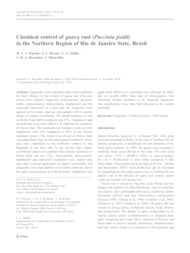Chemical control of guava rust (Puccinia psidii) in the Northern Region of Rio de Janeiro State, Brazil.
Chemical control of guava rust (Puccinia psidii) in the Northern Region of Rio de Janeiro State, Brazil.
Autoria: MARTINS, M. V. V.; SILVEIRA, S. F.; MAFFIA, L. A.; ROCABADO, J. M. A.; MUSSI-DIAS, V.
Resumo: Fungicides were evaluated under field conditions for their efficacy in the control of guava rust (Puccinia psidii); five systemic fungicides (azoxystrobin, pyraclostrobin, cyproconazole, tebuconazole, triadimenol) and the protectant mancozeb. In a first trial, the fungicides were applied at two-week intervals intercalated with bi-weekly sprays of copper oxychloride. The initial incidence of rust on flower buds before treatment was 47%. Triadimenol and azoxystrobin were most effective in reducing the incidence of rust on fruit. The minimum rust incidence achieved with triadimenol was 12% compared to 84% in the control treatment (water). The initial level of rust on flower buds was particularly high for the tebuconazole treatment, which may have contributed to the ineffective control by this fungicide in the first trial. In the second trial, copper oxychloride sprays were applied when disease incidence on flower buds was low (7%). Azoxystrobin, tebuconazole, triadimenol and mancozeb treatments were started nine days after a second application of copper oxychloride. The fungicides were then applied at bi-weekly intervals and at the same concentrations as in the first trial. Triadimenol was again most effective in controlling rust, although its effect did not greatly differ from that of tebuconazole. The maximum disease incidence in all fungicide treatments was significantly lower than that observed in the control treatment.
Ano de publicação: 2011
Tipo de publicação: Artigo de periódico
Unidade: Embrapa Agroindústria Tropical
Palavras-chave: Psidium Guajava, Yield losses, fungicides
Observações
1 - Por padrão são exibidas publicações dos últimos 20 anos. Para encontrar publicações mais antigas, configure o filtro ano de publicação, colocando o ano a partir do qual você deseja encontrar publicações. O filtro está na coluna da esquerda na busca acima.
2 - Para ler algumas publicações da Embrapa (apenas as que estão em formato ePub), é necessário ter, no celular ou computador, um desses softwares gratuitos. Sistemas Android: Google Play Livros; IOS: iBooks; Windows e Linux: software Calibre.
Acesse outras publicações
Acesse a Base de Dados da Pesquisa Agropecuária (BDPA) para consultar o acervo completo das bibliotecas da Embrapa.

